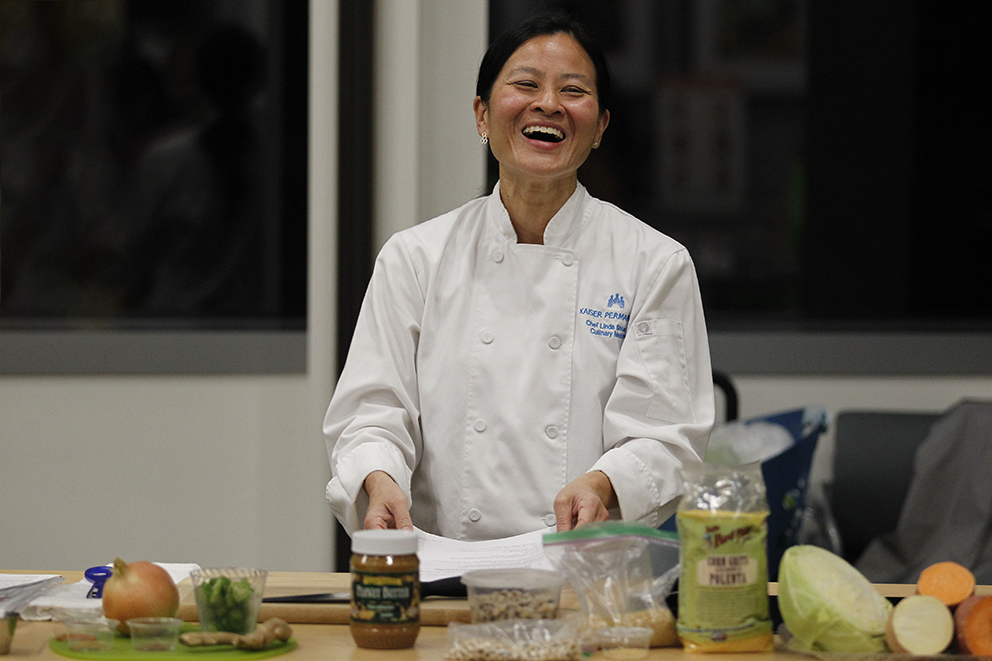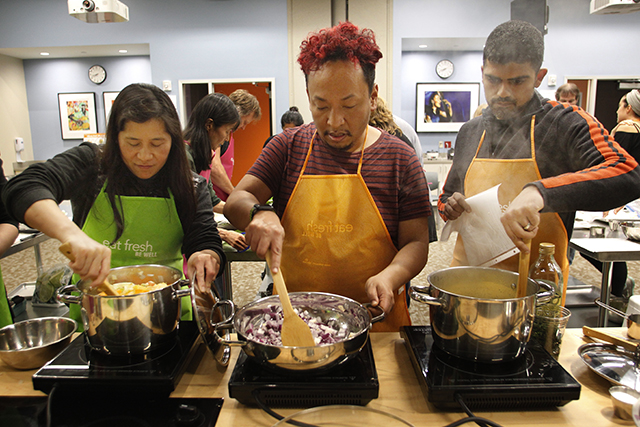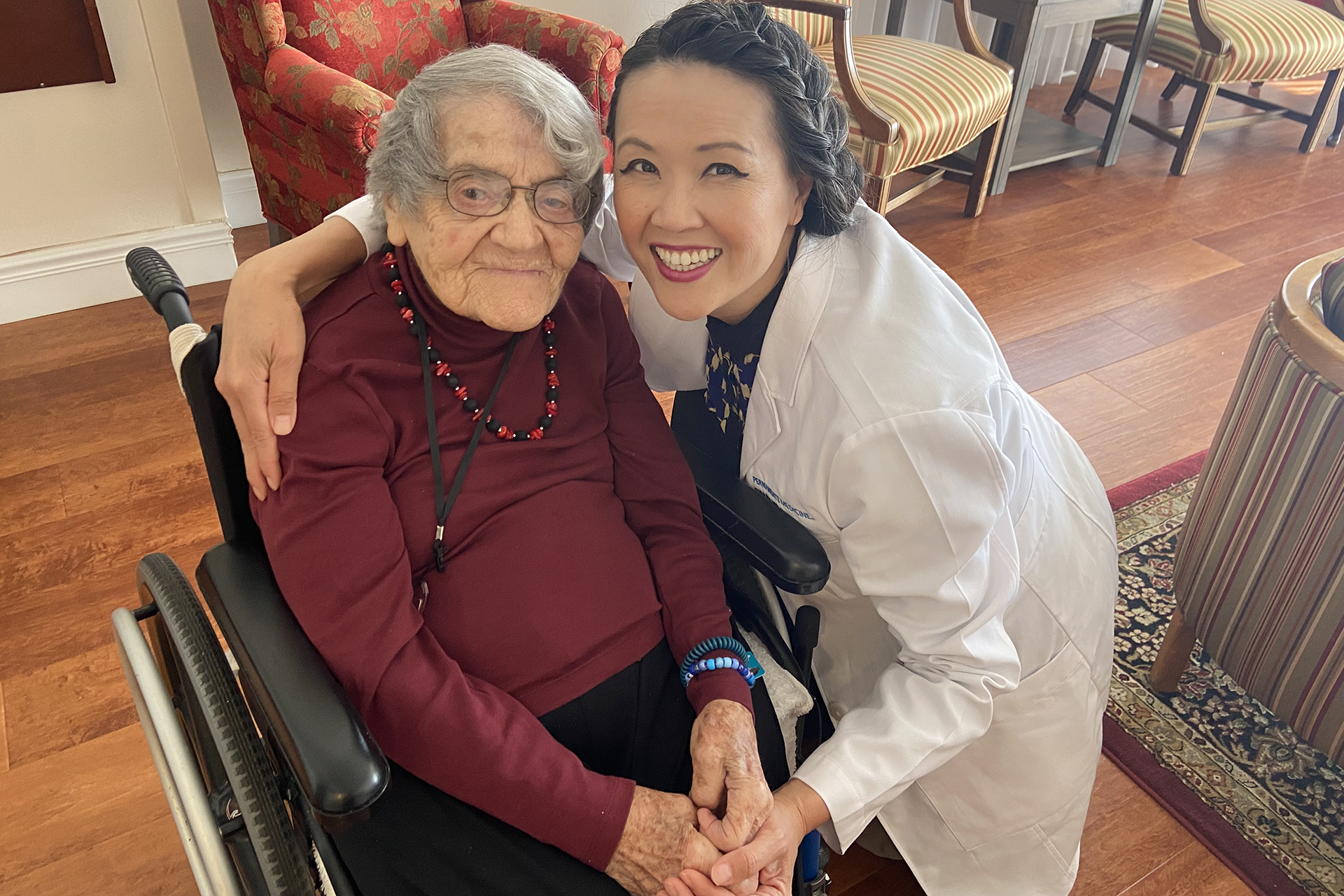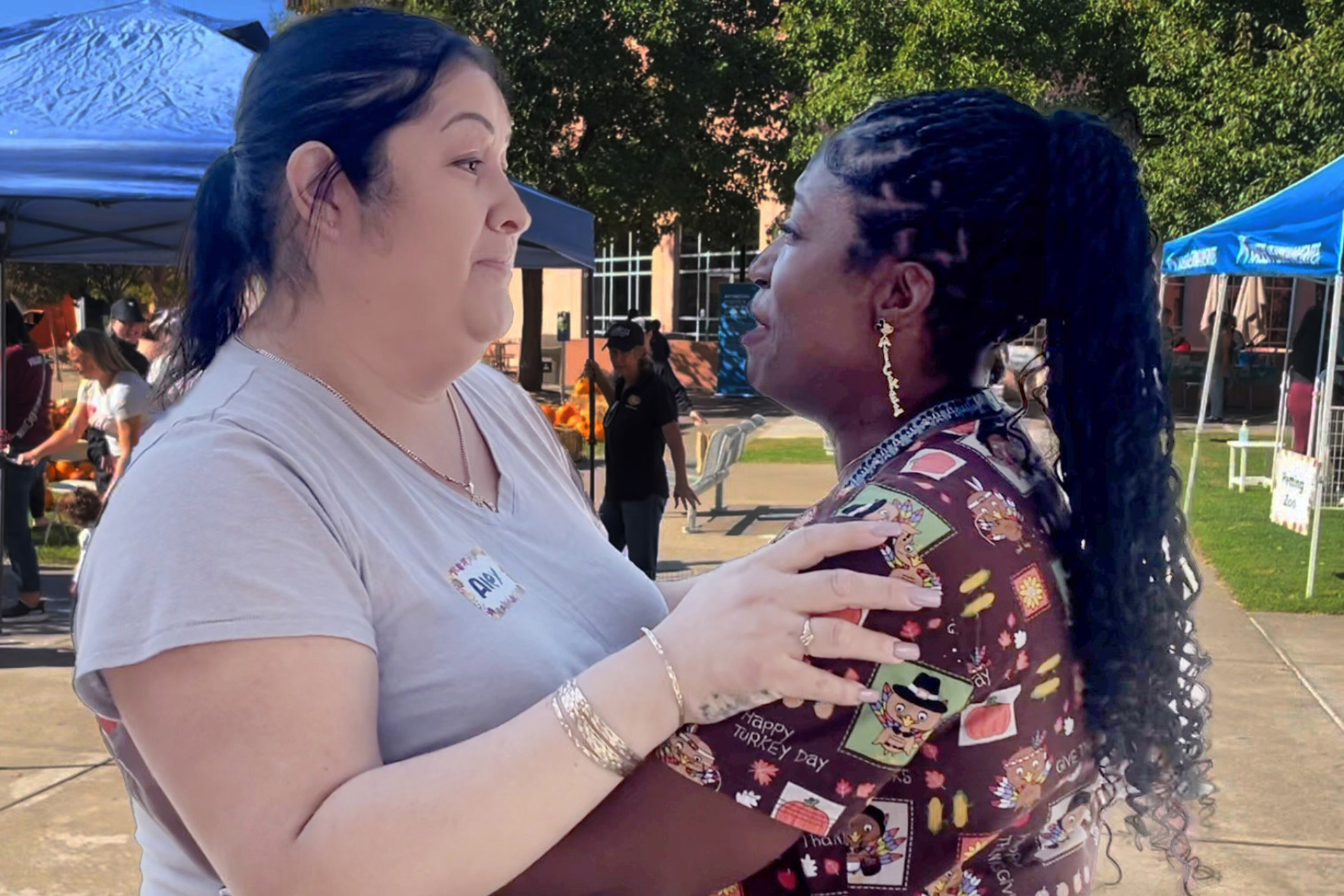West African Groundnut Stew. Texas Caviar in Collard Green Cups. Jamaican Rice and Peas. Grits with Spicy Collard Greens.
That’s what was for dinner Feb. 13 at the Kaiser Permanente Mission Bay Medical Center when Linda Shiue, MD, converted a conference room into the Thrive Kitchen for a cooking class open to Kaiser Permanente members and the public.
These ingredients are also the basis for what’s for dinner in Senegal, according to Dr. Shiue, who visited the country recently.
191502_Food_01
Dr. Shiue is an internal medicine physician, a trained chef, a sought-after speaker on food as medicine, and was an anthropology major in college. She brings it all together in her monthly cooking class now entering its third year.
“My goal is to give people practical skills for implementing healthy eating and cooking at home,” she said. “The idea behind that is preventive health. A healthy diet is a one-size-fits-all first-defense medicine against diabetes, heart disease, high cholesterol, and even cancer.”
Lessons from Linda
Tonight’s menu was chosen by Dr. Shiue to honor the diverse population that “makes the Bay Area great.”
The evening is dedicated to the traditional cuisine of Africa, packed with leafy green and root vegetables and grains. “The traditional ingredients of African cuisine are really good for you,” she said, adding that tonight’s stew is special to her: She first made it for her husband 27 years ago this month.
With 12 students in the class supported by volunteers who include fellow physicians as well as nutrition and culinary professionals, Dr. Shiue runs through the menu, has students share their cooking experience, and begins demonstrating kitchen tips and tricks:
• Use pre-cut vegetables to save yourself time
• Frozen vegetables are inexpensive and often “flash frozen,” so have plenty of nutrients and can be a good choice for soups and stews
• Brown par-boiled rice has more vitamins than white rice, with a similar texture
• Hold your knife handle closer to the blade, then cut and dice using a rocking motion
• Don’t peel ginger with a grater; use the edge of a spoon
“In polls most Americans don’t cook at home as much anymore,” Dr. Shiue said. “In the 70s and 80s more mothers and fathers were working, so we raised a generation that couldn’t cook. At the same time, we saw a rise in chronic conditions. As a result, we learned that eating at home meant better health outcomes.”
Students of Food
Soon the conference room starts to look like a restaurant kitchen, with teams of 4-5 students slicing, dicing, and sautéing everything from okra to jalapeno peppers. With dustings of allspice, cumin, and cayenne, it begins to smell like a kitchen, too. The students are largely strangers to one another, but they pepper their work with laughter and chatter.
Kevin Tan is sautéing onions and garlic. The special education teaching assistant with the San Francisco Unified School District has lost 80 pounds with Kaiser Permanente’s Weight Management Program. He’s given up the sodas, white rice, and soy sauce he loved for the vegetables he used to avoid.
“Now I like all kinds of vegetables,” he said. “Spinach is my favorite. I’m here to learn more about making healthy food.”
At another table, Hannah Schmunk is chopping vegetables. She works as a food educator for children at Bon Appetit Management Company and volunteered at an orphanage in Tanzania for 4 months, where she taught cooking, too.
Two years ago, she was diagnosed with Lyme disease, and her interest in food became personal as she sought a diet that would reduce inflammation. “I believe in the healing power of good food,” she said. “I’d love to see more hospitals offer food as medicine in programs like this one.”
Like clockwork, the dishes are finished and the class’s enthusiastic eating begins.
“Food is about community building,” Dr. Shiue said. “People start out as strangers, but when people cook together it always draws them closer.”
Upcoming classes include “Eat Your Greens” on March 13, “Spring Vegetables” on April 10, and “Healthy Asian Cooking” on May 8. To sign up, call 415-833-3450 or email SFhealthed@kp.org. More information is also available at www.Facebook.com/TheDoctorsSpicebox. Check out the stew recipe, below!
West African Groundnut Stew (Mafe)
Adapted from Sundays at Moosewood Restaurant, 1990, Simon and Schuster.
This is a vegan version of mafe, a peanut based stew popular throughout W. Africa, which includes the countries of Senegal, Ghana, Nigeria, and others.
Serves 12
Ingredients
2 cups chopped onions
2 tablespoons vegetable oil
1/2 to 1 tsp cayenne pepper
2 garlic cloves, peeled and crushed
2 cups chopped cabbage
3 cups cubed sweet potatoes (1-inch cubes)
3 cups low sodium tomato juice
1 cup apple juice
1 teaspoon salt
1 teaspoon grated peeled fresh ginger root
1 tablespoon chopped fresh cilantro
2 tomatoes, chopped
2 cups chopped okra
½ cup natural peanut butter (no other added ingredients)
Technique
1. Sauté the onions in oil over medium heat for about 10 minutes, until onions are translucent.
2. Stir in the cayenne and garlic and sauté for a couple more minutes.
3. Add the cabbage and sweet potatoes and sauté, covered for a few minutes.
4. Mix in the juices, salt, ginger, cilantro, and tomatoes.
5. Cover and simmer for about 15 minutes, until the sweet potatoes are tender.
6. Add the okra and simmer for 5 minutes more.
7. Stir in the peanut butter, and simmer gently until ready to serve, stirring frequently. Add more juice or water if the stew is too thick.
8. Serve over rice or fufu (a starch made of pounded boiled cassava).
Nutrition Info: Cal 186, Fat 8 g, Protein 5 g, Sodium 249 g, Sugar 11 g






This Post Has 7 Comments
I was inspired to learn more about the African heritage diet from Oldways, a website devoted to healthy cooking and eating, featuring the food traditions of diverse cultures.
Loved this story! Kudos to Dr. Shiue for sharing her knowledge and enthusiasm for tasty, healthy cooking with Kaiser Permanente members and the community.
Thanks for sharing, saw you present recently at HKHL too.
Where can I get all the recipes listed in this article.. They sound awesome!!
To sign up or ask for the recipes, call 415-833-3450 or email SFhealthed@kp.org. More information is also available at http://www.Facebook.com/TheDoctorsSpicebox.
Yes, Indian Vegetarian or even Vegan would be great. I loved reading this and I’m going to try this recipe at home!
This is awesome. I would love to teach an Indian Vegetarian class if possible.